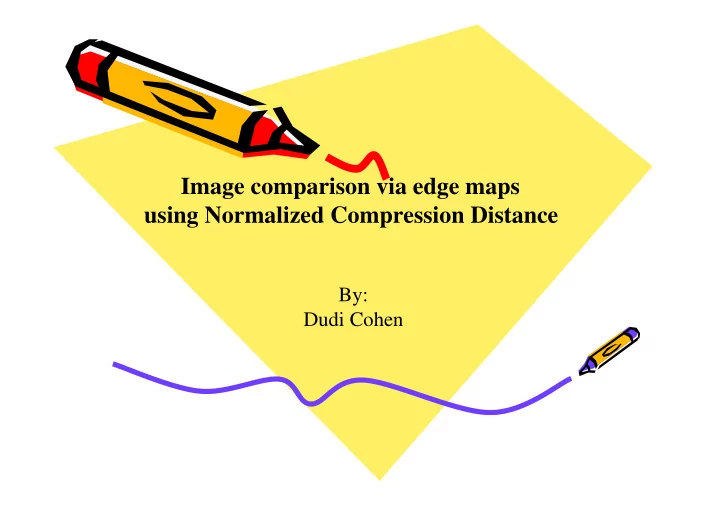

Image comparison via edge maps using Normalized Compression Distance By: Dudi Cohen
Image comparison • Image comparison is a method of computing how different or similar two or more images are from each other. • There are multiple methods of image comparison, each method varies from the other mainly by two elements: – Image features being compared. – Feature comparison method.
Why use edge maps? • In my project I suggest an image comparison method in which the compared feature is the image’s edge map. • We would like to use this sort of method when: – Colors aren’t needed to be accounted for defining the similarity. – Edges and contours are a big factor in the images. ? ? = =
How to compare edge maps? • The main problem with comparing edge maps is choosing the comparison method: – Edges can appear in different coordinates in the image. – Edges can appears in different orientations in the image. • Methods such as least square or hamming distance will not give us the proper results. • For the comparison method I’ve used Normalized Compression Distance.
Kolmogorov complexity • Kolmogorov complexity is the length of the shortest binary program to create an object. • For example to create a black grayscale image, the C program is: – For (int i=0 ;i<width;i++) for (int j=0;j<height;j++) I[i][j]=0; • K(x|y): length of the shortest program p that creates x from an input y • K(x): length of the shortest program p that creates x from an input y=the empty word.
Kolmogorov complexity (cont.) • It is easy to see that we can use K(x|y) as a method to compare the similarity of 2 objects. • K(x) is actually the ultimate compressed version of x: takes advantage of every redundancy in x. • All the information in x is concentrated in it’s shortest program. • Unfortunately K(x) isn’t computable, so we need to find a method to give us a good approximation. • K(x) uses redundancy, so why not use a compressor?
Normalized Compression Distance (NCD) • Compressors use redundancy in an object to encode it in a shorter way. Therefore it seems natural to approximate K(x) by C(x)- the compressed version of x: − ( ) min{ ( ), ( )} C xy C x C y = ( , ) NCD x y max{ ( ), ( )} C x C y • If two objects are similar then the length of the compressed version of their union should be close to the length of their compressed version • NCD(x,y)=0 ; identity • NCD(x,y)=1 ; most different
“Support Tools” • I needed to select an edge detector and an effective compressor: – Edge detection was done using the Canny edge detector. – Compression was accomplished by implementing a Universal Lossless Data Compression of ROBDD (Reduced Ordered Binary Decision Diagram). • Note: Further research and projects can be done using other edge detectors and compressors.
Conducted experiments • I used a database which included images of different types: simple sketches, cartoons, individual objects and complex photos. • Most of the comparisons made a good match of similar edge maps. • Complex pictures which had a lot of noise that affected the edge detections had more difficulty to properly find a match.
Some Examples (Smallest NCD) • Simple and similar contours of the same shifted object
Some Examples (Smallest NCD) • Complex contours of shifted complex objects
Some Examples (Largest NCD) • Simple and different contours of different objects
Conclusions • The method works good with edge maps without a lot of noise, and therefore is efficient only for certain image databases. • Some possibilities exist to improve the results of this method by using a different compressor and/or a different edge detection method. • NCD is a good and efficient method of measuring distance between objects/information.
References • J. Kiefer, P. Flajolet, and E-h. Yang. Universal Lossless Data Compression Via Binary Decision Diagrams • Ming Li , Xin Chen, Xin Li, Bin Ma, and Paul M. B. Vitányi. The Similarity Metric • Rudi Cilibrasi, Paul Vitányi and Ronald de Wolf. Algorithmic Clustering of Music Based on String Compression • Xin-Jing Wang, Lei Zhang, Feng Jing and Wei-Ying Ma. Image Annotation Using Search and Mining Technologies
Recommend
More recommend